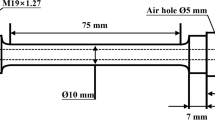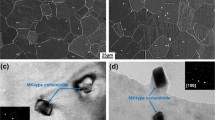In the present study, the out-of-phase thermomechanical fatigue (OP-TMF) behavior of a cast aluminum-silicon-magnesium alloy, the A356.0 alloy which has been widely used in diesel engine cylinder heads, is compared to room-temperature and high-temperature low cycle fatigue (RT-, HT-LCF) behaviors. For this purpose, strain/temperature-controlled isothermal and non-isothermal fatigue tests were performed based on realistic loading conditions in cylinder heads. Fatigue tests results showed that the plastic strain increased during cycles under constant mechanical strain amplitude, while the specimen failed. Under LCF loadings, the cyclic hardening occurred at low temperatures for the A356.0 alloy and the cyclic softening occurred at high temperatures, as it was also observed in TMF tests. The radial and longitudinal temperature gradients during TMF tests were almost 2 and 3°C, respectively. Comparing stress-strain hysteresis loops, tensile stresses at minimum temperatures under TMF loadings were more than tensile stresses at LCF cases, due to the out-of-phase loading condition in TMF tests. In this state, maximum temperatures occurred within compressive regimes and minimum temperatures occurred at tensile loads. In general, TMF lifetimes were less than LCF ones due to severe conditions and the temperature deviation in TMF tests.









Similar content being viewed by others
References
J. Z. Yi, P. D. Lee, T. C. Lindley, and T. Fukui, “Statistical modeling of microstructure and defect population effects on the fatigue performance of cast A356-T6 automotive components,” Mater. Sci. Eng. A, 432, 59–68 (2006).
A. Moridi, M. Azadi, and G. H. Farrahi, “Coating thickness and roughness effect on stress distribution of A356.0 under thermo-mechanical loadings,” Proc. Eng., 10, 1372–1377 (2011).
A. Moridi, M. Azadi, and G. H. Farrahi, “Thermo-mechanical stress analysis of thermal barrier coating system considering thickness and roughness effects,” Surf. Coat. Technol., 243, 91–99 (2012).
D. L. McDowell, K. Gall, M. F. Horstemeyer, and J. Fan, “Microstructure-based fatigue modeling of cast A356-T6 alloy,” Eng. Fract. Mech., 70, 49–80 (2003).
B. Atzori, G. Meneghetti, and L. Susmel, “Fatigue behavior of AA356-T6 cast aluminum alloy weakened by cracks and notches,” Eng. Fract. Mech., 71, 759–768 (2004).
X. Zhu, A. Shyam, J. W. Jones, et al., “Effects of microstructure and temperature on fatigue behavior of E319-T7 cast aluminum alloy in very long life cycles,” Int. J. Fatigue, 28, 1566–1571 (2006).
Y. X. Gan and R. A. Overfelt, “Fatigue property of semisolid A357 aluminum alloy under different heat treatment conditions,” J. Mater. Sci., 41, 7537–7544 (2006).
J. Z. Yi, Y. X. Gao, P. D. Lee, and T. C. Lindley, “Microstructure-cased fatigue life prediction for cast A356-T6 aluminum-silicon alloys,” Metall. Mater. Trans. B, 37, 301–311 (2006).
D. L. McDowell, “Simulation-based strategies for microstructure-sensitive fatigue modeling,” Mater. Sci. Eng. A, 468-470, 4–14 (2007).
H. R. Ammara, A. M. Samuela, and F. H. Samuel, “Porosity and the fatigue behavior of hypoeutectic and hypereutectic aluminum–silicon casting alloys,” Int. J. Fatigue, 30, 1024–1035 (2008).
M. A. Bayoumi, M. I. Negma, and A. M. El-Gohry, “Microstructure and mechanical properties of extruded Al-Si alloy (A356) in the semi-solid state,” Mater. Des., 30, 4469–4477 (2009).
J. J. I. Mattos, A. Y. Uehara, M. Sato, and I. Ferreira, “Fatigue properties and micro-mechanism of fracture of an AlSiMg0.6 cast alloy used in diesel engine cylinder head,” Proc. Eng., 2, 759–765 (2010).
P. K. Rohatgi, S. Alaraj, R. B. Thakkar, and A. Daoud, “Variation in fatigue properties of cast A359-SiC composites under total strain controlled conditions: effects of porosity and inclusions,” Compos. Part A, 38, 1829–1841 (2007).
A. R. Emami, S. Begum, D. L. Chen, et al., “Cyclic deformation behavior of a cast aluminum alloy,” Mater. Sci. Eng. A, 516, 31–41 (2009).
S. Mousheng and R. Maowu, “Microstructures and properties of low cycle fatigue of electrolytic A356 alloys,” Mater. Charact., 62, 367–372 (2011).
T. Takahashi, Y. Sugimura, and K. Sasaki, “Thermal plastic-elastic analysis in consideration of metallurgical microstructure,” J. Manuf. Sci. Eng., 126, 25–32 (2004).
T. J. Smith, H. J. Maier, H. Sehitoglu, et al., “Modeling high-temperature stress-strain behavior of cast aluminum alloys,” Metall. Mater. Trans. A, 30, 133–146 (1999).
H. Sehitoglu, X. Qing, T. Smith, et al., “Stress-strain response of a cast 319-T6 aluminum under thermo-mechanical loading,” Metall. Mater. Trans. A, 31, 139–151 (2000).
T. Beck, K. H. Lang, and D. Löhe, “Thermal-mechanical fatigue behavior of cast aluminum alloys for cylinder heads reinforced with 15 vol.% discontinuous Al2O3 (Saffil) fibers,” Mater. Sci. Eng. A, 319-321, 662–666 (2001).
J. Luft, T. Beck, and D. Löhe, “Lifetime and damage behavior of a cast aluminum alloy under TMF and superimposed TMF/HCF loading,” in: Proc. of the 11th Int. Conf. on Fracture (March 20–25, 2005, Turin), Politecnico di Torino, Turin, Italy (2005), Vol. 4, pp. 2664–2669.
T. Beck, D. Löhe, J. Luft, and I. Henne, “Damage mechanisms of cast Al-Si-Mg alloys under superimposed thermal-mechanical fatigue and high-cycle fatigue loading,” Mater. Sci. Eng. A, 468-470, 184–192 (2007).
T. Beck, I. Henne, and D. Löhe, “Lifetime of cast AlSi6Cu4 under superimposed thermal-mechanical fatigue and high-cycle fatigue loading,” Mater. Sci. Eng. A, 483-484, 382–386 (2008).
J. J. Thomas, L. Verger, A. Bignonnet, and S. M. Borret, “Thermo-mechanical design in the automotive industry,” SAE Int., Paper No. 2002-01-0659 (2002).
J. J. Thomas, L. Verger, A. Bignonnet, and E. Charkaluk, “Thermo-mechanical design in the automotive industry,” Fatigue Fract. Eng. Mater. Struct., 27, 887–895 (2004).
W. W. Bose-Filho, E. R. de Freitas, V. F. da Silva, et al., “Al-Si cast alloys under isothermal and thermo-mechanical fatigue conditions,” Int. J. Fatigue, 29, 1846–1854 (2007).
M. Riedler, C. Czettl, R. Minichmayr, et al., “Thermo-mechanical fatigue lifetime assessment with damage-parameters, energy-criteria and cyclic-J-integral concepts,” in: Proc. of the 16th Eur. Conf. on Fracture (July 3–7, 2006), Alexandroupolis, Greece (2006).
M. Riedler, H. Leitner, B. Prillhofer, et al., “Lifetime simulation of thermo-mechanically loaded components,” Meccanica, 42, 47–59 (2007).
T. Takahashi and K. Sasaki, “Low cycle thermal fatigue of aluminum alloy cylinder head in consideration of changing metrology microstructure,” Proc. Eng., 2, 767–776 (2010).
M. B. Grieb, H. J. Christ, and B. Plege, “Thermo-mechanical fatigue of cast aluminum alloys for cylinder head applications – experimental characterization and life prediction,” Proc. Eng., 2, 1767–1776 (2010).
M. Azadi, A. Mafi, M. Roozban, and F. Moghaddam, “Failure analysis of a crack gasoline engine cylinder head,” J. Fail. Anal. Prev., 12, No. 3, 286–294 (2012).
M. Azadi, M. M. Shirazabad, “Heat treatment effect on thermo-mechanical fatigue and low cycle fatigue behaviors of A356.0 aluminum alloy,” Mater. Des., 45, 279–285 (2013).
M. Azadi, “Effects of strain rate and mean strain on cyclic behavior of aluminum alloys under isothermal and thermo-mechanical fatigue loadings,” Int. J. Fatigue, 47, 148–153 (2013).
M. Azadi, G. H. Farrahi, G. Winter, and W. Eichlseder, “The effect of various parameters on out-of-phase thermo-mechanical fatigue lifetime of A356.0 cast aluminum alloy,” Int. J. Eng. Trans. C: Aspects, 26, No. 12, 1461–1470 (2013).
G. H. Farrahi, M. Azadi, G. Winter, and W. Eichlseder, “A new energy-based isothermal and thermomechanical fatigue lifetime prediction model for aluminum-silicon-magnesium alloy,” Fatigue Fract. Eng. Mater. Struct., 36, No. 12, 1323–1335 (2013).
G. H. Farrahi, M. Ghodrati, and M. Azadi, “Finite element analysis of thermal and mechanical stresses in diesel engine cylinder head using two-layer elastic-visco-plastic model,” J. Eng. Res., 28, 51–60 (2012).
G. H. Farrahi, A. Shamloo, M. Felfeli, and M. Azadi, “Numerical simulations of cyclic behaviors in light alloys under isothermal and thermo-mechanical fatigue loadings,” Mater. Des., 56, 245–253 (2014).
S. Tabibian, E. Charkaluk, A. Constantinescu, et al., “TMF criteria for lost foam casting aluminum alloys,” Fatigue Fract. Eng. Mater. Struct., 36, 349–360 (2013).
S. Tabibian, E. Charkaluk, A. Constantinescu, et al., “TMF-LCF life assessment of a lost foam casting A319 aluminum alloy,” Int. J. Fatigue, 53, 75–81 (2013).
E. Charkaluk, A. Constantinescu, F. Szmytka, and S. Tabibian, “Probability density functions: from porosities to fatigue lifetime,” Int. J. Fatigue, 63, 127–136 (2014).
A. F. Liu, Mechanics and Mechanisms of Fracture: An Introduction, ASM International (2005).
S. S. Manson and G. R. Halford, Fatigue and Durability of Structural Materials, ASM International (2006).
M. Azadi, G. H. Farrahi, G. Winter, and W. Eichlseder, “Thermo-mechanical behaviors of light alloys in comparison to high temperature isothermal behaviors,” Mater. High Temp., 31, No. 1, 12–17 (2014).
Acknowledgments
Authors thank Irankhodro Powertrain Company (IPCO) in Iran and University of Leoben in Austria, for their financial support.
Author information
Authors and Affiliations
Corresponding author
Additional information
Translated from Problemy Prochnosti, No. 6, pp. 71 – 83, November – December, 2015.
Rights and permissions
About this article
Cite this article
Azadi, M., Winter, G., Farrahi, G.H. et al. Comparison Between Isothermal and Non-Isothermal Fatigue Behavior in a Cast Aluminum-Silicon-Magnesium Alloy. Strength Mater 47, 840–848 (2015). https://doi.org/10.1007/s11223-015-9721-4
Received:
Published:
Issue Date:
DOI: https://doi.org/10.1007/s11223-015-9721-4




